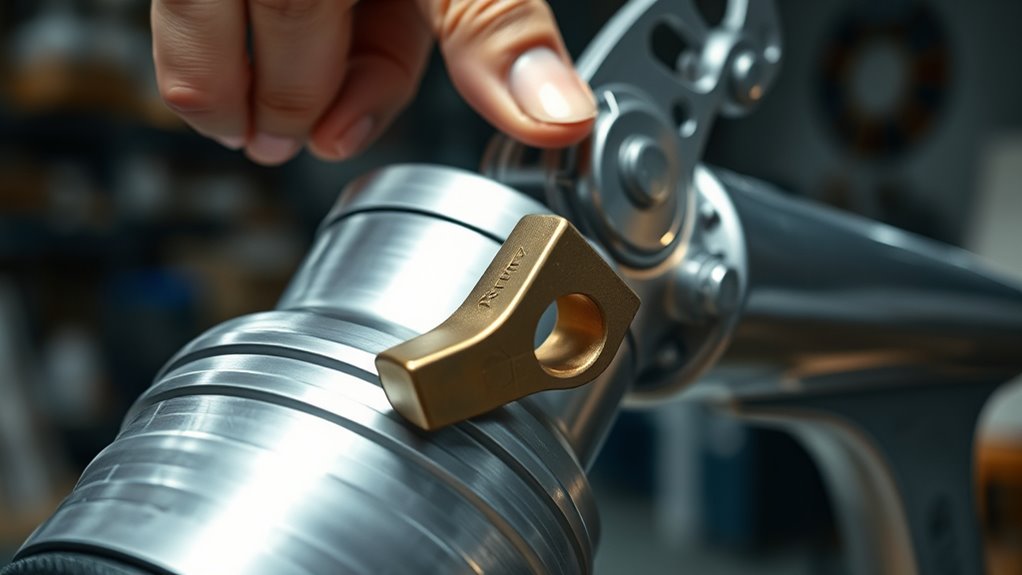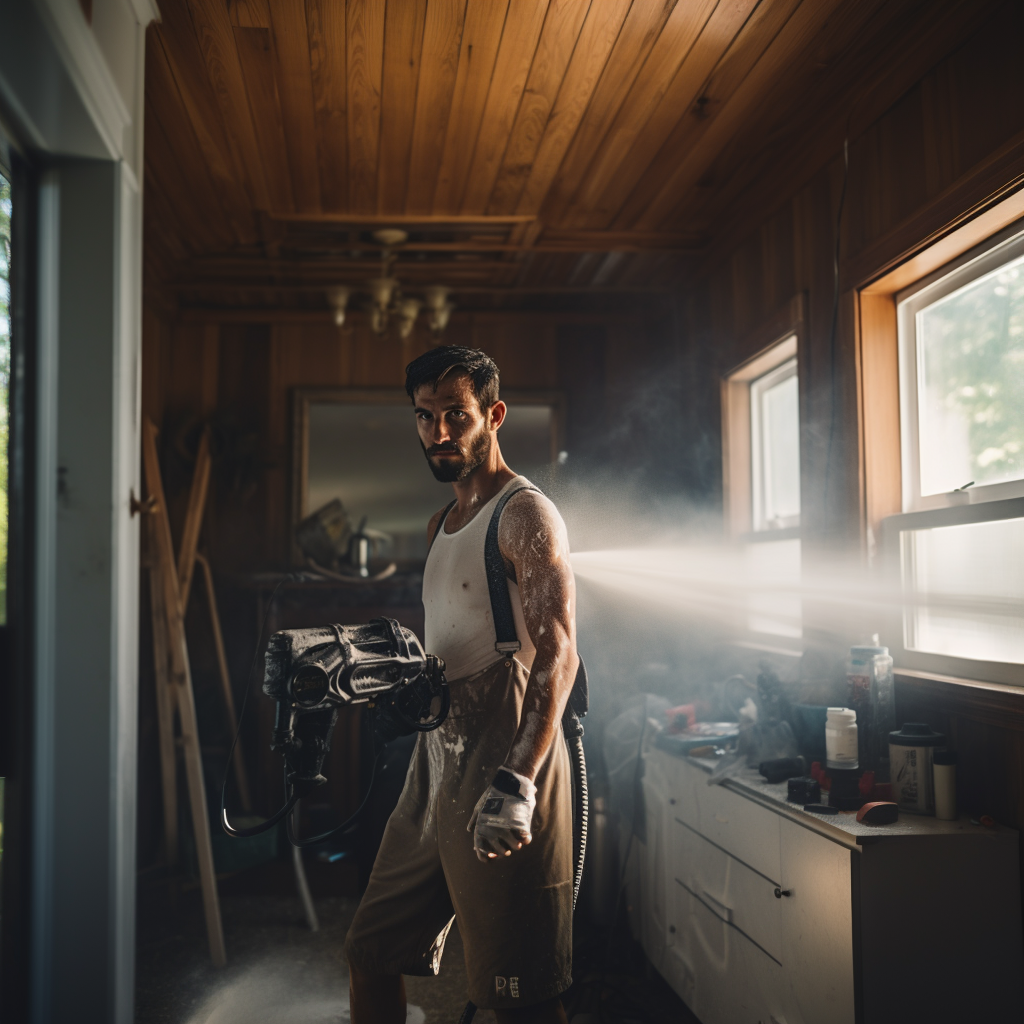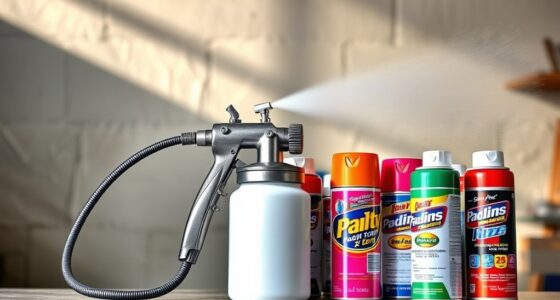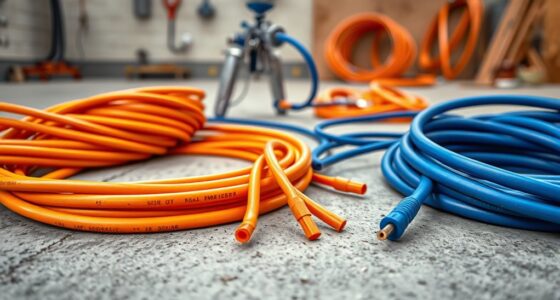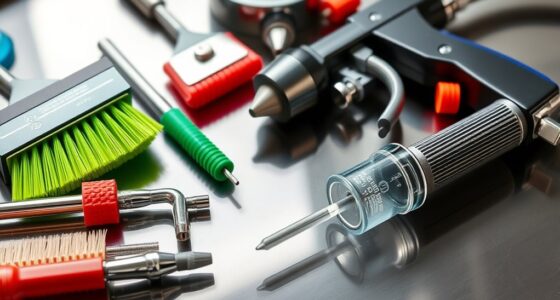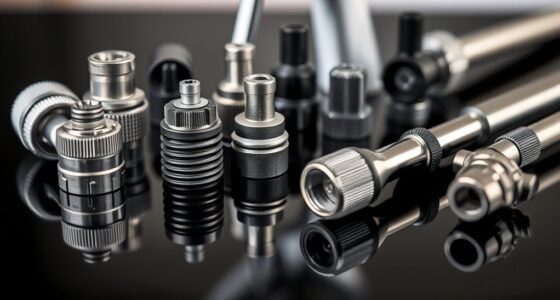Yes, you should worry about static electricity when using your paint sprayer, as static buildup can cause sparks, fires, or electrical shocks. Proper grounding directs static charges safely into the ground, preventing dangerous sparks and protecting both you and your equipment. Making sure your sprayer is grounded correctly is essential for safety and efficient operation. If you want to learn more about proper grounding techniques and safety tips, keep exploring to ensure you’re fully protected.
Key Takeaways
- Yes, static electricity can build up during spraying, posing a fire and shock risk if not properly grounded.
- Proper grounding directs static charges safely into the ground, preventing sparks and electrical hazards.
- Regularly inspect and maintain grounding wires to ensure effective static dissipation.
- Follow manufacturer instructions for grounding to ensure safety and optimal equipment performance.
- Neglecting grounding increases static buildup, risking shocks, fires, and equipment damage.
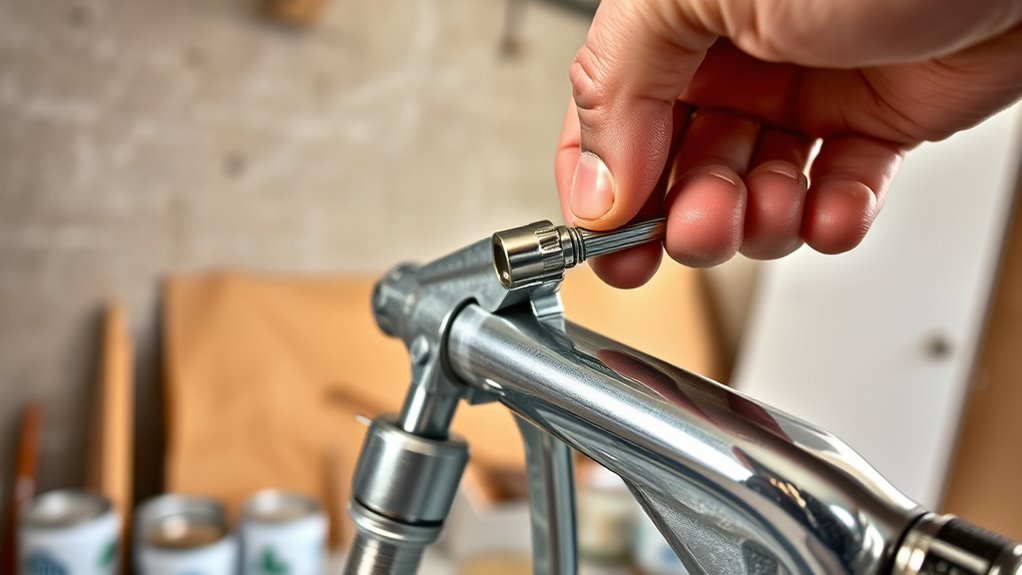
Grounding a paint sprayer is a essential safety step that helps prevent electrical shocks and equipment damage. When you’re working with high-voltage equipment like sprayers, understanding how grounding contributes to electrical safety is indispensable. Proper grounding ensures that any stray electrical current or static electricity is safely directed into the ground, reducing the risk of shocks to you and others nearby. It’s not just about personal safety; it also plays a critical role in maintaining your equipment’s longevity. Without proper grounding, static buildup can occur during spraying, which might lead to sparking or even fires in some cases. These sparks can damage sensitive parts of your sprayer, leading to costly repairs or replacements, so it’s crucial to get it right from the start.
In terms of equipment maintenance, grounding your paint sprayer isn’t a task you should overlook. Regularly inspecting your grounding wire and connections helps prevent deterioration over time. Corrosion, loose fittings, or damaged wires can compromise the grounding system, making it ineffective. This not only jeopardizes electrical safety but also increases the likelihood of static buildup, which can cause operational issues. Making sure that your equipment is properly grounded before every use is a simple but essential step in your maintenance routine. It guarantees that static electricity doesn’t accumulate and lead to unpredictable malfunctions. Keeping your sprayer properly grounded also extends its lifespan by reducing stress on electrical components and preventing damage caused by electrical surges. Additionally, understanding the science behind sound vibrations can help explain how static charges are generated during spraying and why grounding is so important.
You should always follow the manufacturer’s instructions when grounding your paint sprayer. Typically, this involves connecting a grounding wire from the sprayer to a grounded outlet or grounding rod. Make sure your outlet is properly grounded by testing it with a circuit tester; a faulty outlet can undermine your efforts and compromise safety. If you’re unsure about the grounding process or notice any signs of wear or damage in the grounding system, it’s best to consult a professional. Proper grounding isn’t just about following a procedure; it’s about making sure ongoing electrical safety and reliable equipment performance. When done correctly, it minimizes static electricity buildup and protects both you and your sprayer from electrical hazards.
Frequently Asked Questions
Can Static Electricity Cause Sparks During Outdoor Painting?
Yes, static electricity can cause sparks during outdoor painting, especially if there’s a significant electrostatic discharge. When your paint sprayer builds up static, a sudden spark risk increases, which can be hazardous. To prevent this, make certain proper grounding of your equipment. Keeping your spray gun and surrounding area grounded reduces static buildup, lowering the chance of sparks and making your outdoor painting safer and more efficient.
Is Grounding Necessary for All Types of Paint Sprayers?
You might wonder if grounding is necessary for all paint sprayers. Many grounding myths exist, but static risks differ by sprayer type. For example, airless sprayers usually don’t need grounding, while HVLP or siphon feed units may require it to prevent static buildup. Check your sprayer’s instructions, and don’t assume grounding is always essential—know your equipment and stay safe from potential static hazards.
How Often Should I Check My Paint Sprayer’s Grounding Connection?
Did you know that improper grounding causes over 50% of electrical accidents in spray painting? You should check your paint sprayer’s grounding connection regularly—ideally before each use or after every few hours of work. Follow consistent inspection intervals to guarantee safety and prevent static buildup. Frequent checks help catch loose connections early, protecting you from potential shocks or fires. Stay vigilant with grounding to keep your projects safe and efficient.
Are There Specific Safety Standards for Grounding Paint Equipment?
You should know that grounding standards and safety regulations vary depending on your location and the type of equipment. It’s essential to adhere to the specific safety standards set by OSHA or local authorities, which often require proper grounding to prevent static electricity buildup. Always verify your paint equipment meets these safety regulations, and regularly inspect your grounding connections to keep your work environment safe and compliant.
What Are the Signs That My Paint Sprayer Is Not Properly Grounded?
You might notice a tingling sensation or small sparks when operating your paint sprayer, which signals improper grounding. Ignoring grounding myths can lead you to overlook electrical hazards that could cause shocks or fires. Always check for inconsistent spray patterns or uneven paint application, as these can also indicate grounding issues. Proper grounding practices are essential to prevent electrical hazards and guarantee safe, effective painting.
Conclusion
Just like a lightning rod channels a storm’s energy safely to the ground, grounding your paint sprayer directs static electricity away from you. It’s a simple step that keeps you safe and your project smooth sailing. Don’t let static sparks become a storm in your workspace—ground your sprayer and enjoy a worry-free paint job. Remember, a little grounding goes a long way in keeping your work safe and your mind at ease.
Franz came aboard the Paint Sprayer Zone team with a background in both journalism and home renovation. His articulate writing style, combined with a passion for DIY projects, makes him an invaluable asset. Franz has a knack for breaking down technical jargon into easy-to-understand content, ensuring that even the most novice of readers can grasp the complexities of paint sprayers.
